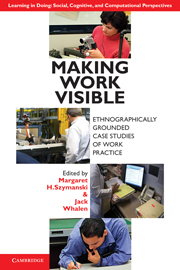Book contents
- Frontmatter
- Contents
- List of Figures and Excerpts
- List of Tables
- List of Contributors
- Series Foreword
- Foreword by John Seely Brown
- Acknowledgments
- Introduction
- Part I Work Practice Study in Historical Context
- Part II Applying Work Practice Methods
- Part III Practices around Documents
- Part IV The Customer Front
- 10 Integrated Customer Service
- 11 Interactions at a Reprographics Store
- 12 Ethnographically Informed Technology for Remote Help-giving
- 13 Sign of the Times at the Department Store
- Part V Learning and Knowledge Sharing
- Part VI Competency Transfer
- References
- Index
- LEARNING IN DOING: SOCIAL, COGNITIVE AND COMPUTATIONAL PERSPECTIVES
11 - Interactions at a Reprographics Store
Published online by Cambridge University Press: 05 August 2012
- Frontmatter
- Contents
- List of Figures and Excerpts
- List of Tables
- List of Contributors
- Series Foreword
- Foreword by John Seely Brown
- Acknowledgments
- Introduction
- Part I Work Practice Study in Historical Context
- Part II Applying Work Practice Methods
- Part III Practices around Documents
- Part IV The Customer Front
- 10 Integrated Customer Service
- 11 Interactions at a Reprographics Store
- 12 Ethnographically Informed Technology for Remote Help-giving
- 13 Sign of the Times at the Department Store
- Part V Learning and Knowledge Sharing
- Part VI Competency Transfer
- References
- Index
- LEARNING IN DOING: SOCIAL, COGNITIVE AND COMPUTATIONAL PERSPECTIVES
Summary
Around the turn of the century, the Knowledge Interaction and Practice Area was a newly formed group of social scientists at PARC with a background in conversation analysis and ethnomethodology aiming to conduct workplace studies for Xerox (see Sharrock and Button, this volume for an overview of the theoretical underpinnings of this approach to studying work). We were keen to pursue a team project so that we could create synergies among our different backgrounds and research interests. Our goal was to secure a business fieldsite for a long-term research project that provided opportunities for interesting research and value to our parent company.
Of course, there is a tension between the long-term open-ended nature of ethnographic research and common business practice. In business, cycles are short because the performance of organizations – and by extension the performance of the sponsors of research – are publicly scrutinized every quarter. The pressure to make headway in some measurable way in a short amount of time – months, sometimes weeks – is great. We were adamant, however, to try and define a project that would satisfy both research and business criteria.
Eastside reprographics, a local chain of copy shops in the San Francisco Bay area, seemed to match our needs well. First, it provided us with ample opportunity to observe people interact with Xerox machines and thus to report on any usability issues.
- Type
- Chapter
- Information
- Making Work VisibleEthnographically Grounded Case Studies of Work Practice, pp. 205 - 224Publisher: Cambridge University PressPrint publication year: 2011

